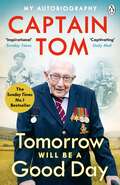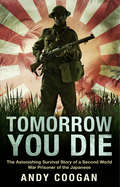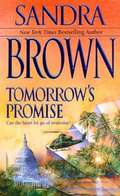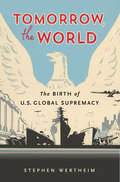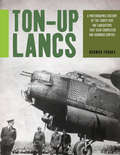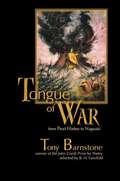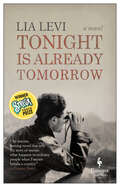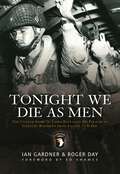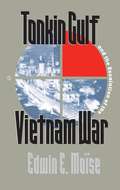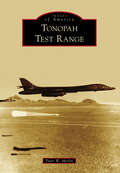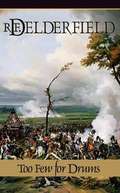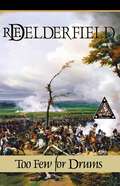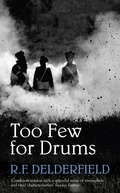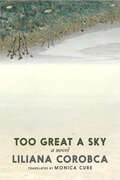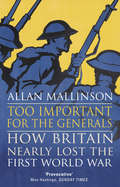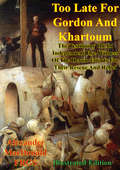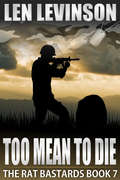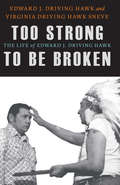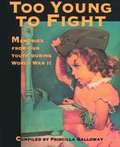- Table View
- List View
Tomorrow Will Be A Good Day: My Autobiography - The Sunday Times No 1 Bestseller
by Captain Tom MooreEmbark on an enchanting journey into our country's past hundred years through the remarkable life of Captain Sir Tom MooreTHE NO. 1 SUNDAY TIMES BESTSELLER'A wonderful life story with lessons for us all . . . beautifully written' DAILY TELEGRAPH'Gloriously enthralling' DAILY MAIL__________Captain Sir Tom Moore's story is all our stories . . .Born at the tail end of the Spanish flu epidemic, Tom Moore was raised in the Yorkshire Dales by a loving family that had not escaped tragedy. Yet when the clouds of war threatened, Tom raised his hand and joined up to fight.The Second World War took him to the Far East, where his can-do spirit was forged. Whether fighting for his life in Burma or helming a firm back home, racing motorbikes or raising a family, he always sought to do his very best. To make a difference to those around him.Captain Tom's story is that of our parents and our grandparents.It is the story of the past hundred years here in Britain.__________'Engaging . . . His upbeat nature shines through and reminds us how much worse this year would have been without him' Evening Standard'A wonderful read. Captain Tom is a beacon of light, and hope, and positivity' Piers Morgan, Life Stories, ITV'A great book' Good Morning Britain'A beautiful book. We have so much to learn from Captain Sir Tom' Chris Evans, Virgin Radio 'Fascinating. It's the life story of an ordinary man who is extraordinary' Michael Ball, BBC Radio 2
Tomorrow You Die: The Astonishing Survival Story of a Second World War Prisoner of the Japanese
by Andy CooganAndy Coogan was born in Glasgow in 1917, the oldest child of poor Irish immigrants. He was tipped for Olympic glory, but a promising running career was interrupted by war service. His capture during the fall of Singapore marked the beginning of a three-and-a-half-year nightmare of starvation, torture and disease.Andy was imprisoned in the notorious Changi camp before being transported to Taiwan, where he worked as a slave in a copper mine and was twice ordered to dig his own grave. He was later taken to Japan on a hellship voyage that nearly killed him, but Andy’s athleticism and spirit enable him to survive an ordeal in which many died.From his poverty-stricken boyhood in the slums of the Gorbals to the atomic wasteland of Nagasaki, Andy’s life story is vividly recounted in Tomorrow You Die, an epic, compassionate tale that will shock, enthral and inspire.
Tomorrow's Air Force: Tracing the Past, Shaping the Future
by Jeffrey J. Smith&“A bold and courageous clarion call from a highly respected serving officer that should be read and heeded by anyone interested in the future of the US Air Force.&” —Everett Dolman, School of Advanced Airpower Studies Looking ahead to future airpower requirements, this engaging and groundbreaking book on the history and future of American combat airpower argues that the US Air Force must adapt to the changes that confront it or risk decline into irrelevance. To provide decision makers with the necessary analytical tools, Jeffrey J. Smith uses organizational modeling to help explain historical change in the USAF and to anticipate change in the future. While the analysis and conclusions it offers may prove controversial, the book aims to help planners make better procurement decisions, institute appropriate long-term policy, and better organize, train, and equip the USAF for the future. &“Those airmen willing to actively engage such discussions would do well to turn to Smith&’s book as the basic point of departure for debates concerning the intricate relationship between the Air Force&’s past, present, and future.&” —Strategic Studies Quarterly &“This book is &‘out of the box&’ thinking and is very timely given the recent and evolving Air Force roles and missions.&” —Brigadier General Al Rachel, USAF (Ret.) &“Colonel Smith has a great grasp of what the forthcoming debate will require. The Congress must reduce the spending at the very time our enemies are overtaking our capabilities. The debate needs to be engaged now. This book comes on the scene at just the right time.&” —Denny Smith former US Congressman and Air Force F-4 pilot
Tomorrow's Promise
by Sandra BrownNew York Times bestselling author Sandra Brown offers a poignant tale of courage, commitment and the strength of love in the face of life's greatest uncertainties. It happened the way attraction happens best: suddenly, passionately, unforgettably. High above the ground on a crowded flight to Washington, D. C. , radio personality Keely Preston felt the irresistible pull of Congressman Dax Devereaux, and nothing would ever be the same. They were speaking at the same congressional hearing about Vietnam soldiers listed as MIA. Keely's husband was among the missing soldiers. He had been her childhood sweetheart, her future, and then, the unanswered question Keely dedicated her life to solving. Until there was Dax. And a new future. But could Keely allow herself to love again, and still honor her past?
Tomorrow, the Killing: Low Town 2
by Daniel PolanskyDark, violent, and shot through with corruption, TOMORROW, THE KILLING is a fantastic successor to THE STRAIGHT RAZOR CURE, one of the most heralded fantasy debuts of recent times.Once he was a hero of the Great War, and then a member of the dreaded Black House. Now he is the criminal linchpin of Low Town. His name is Warden. He thought he had left the war behind him, but a summons from up above brings the past sharply, uncomfortably, back into focus. General Montgomery's daughter is missing somewhere in Low Town, searching for clues about her brother's murder. The general wants her found, before the stinking streets can lay claim to her, too.TOMORROW, THE KILLING was chosen as one of the best novels of 2012 by Forbidden Planet, Fantasy Faction, The Founding Fields and A Fantastical Librarian.
Tomorrow, the World: The Birth Of U. S. Global Supremacy
by Stephen WertheimA new history explains how and why, as it prepared to enter World War II, the United States decided to lead the postwar world.For most of its history, the United States avoided making political and military commitments that would entangle it in European-style power politics. Then, suddenly, it conceived a new role for itself as the world’s armed superpower—and never looked back. In Tomorrow, the World, Stephen Wertheim traces America’s transformation to the crucible of World War II, especially in the months prior to the attack on Pearl Harbor. As the Nazis conquered France, the architects of the nation’s new foreign policy came to believe that the United States ought to achieve primacy in international affairs forevermore.Scholars have struggled to explain the decision to pursue global supremacy. Some deny that American elites made a willing choice, casting the United States as a reluctant power that sloughed off “isolationism” only after all potential competitors lay in ruins. Others contend that the United States had always coveted global dominance and realized its ambition at the first opportunity. Both views are wrong. As late as 1940, the small coterie of officials and experts who composed the U.S. foreign policy class either wanted British preeminence in global affairs to continue or hoped that no power would dominate. The war, however, swept away their assumptions, leading them to conclude that the United States should extend its form of law and order across the globe and back it at gunpoint. Wertheim argues that no one favored “isolationism”—a term introduced by advocates of armed supremacy in order to turn their own cause into the definition of a new “internationalism.”We now live, Wertheim warns, in the world that these men created. A sophisticated and impassioned narrative that questions the wisdom of U.S. supremacy, Tomorrow, the World reveals the intellectual path that brought us to today’s global entanglements and endless wars.
Ton-Up Lancs: A Photographic History of the Thirty-Five RAF Lancasters that Each Completed One Hundred Sorties
by Norman FranksAn updated and expanded photographic history of the famed military aircraft—and the men who flew them. Aviation historian Norman Franks updates his classic book, The Lancaster, with new information and photos. The Avro Lancaster was a four-engine heavy bomber that played a crucial role in World War II, and this illustrated volume records the history of thirty-five of them, supported by stories from aircrew members. The most famous of the bombers is &“Queenie&” (W5868), the only one of these Lancasters that survives, now in the Bomber Command Hall at the Royal Air Force Museum in London. Ton-Up Lancs delves into some of the controversies surrounding Queenie and other Lancasters, and also includes detailed listings of each raid these thirty-five Lancasters flew during from 1942 through 1945, together with the names of the pilot and crew that took them on sorties all over Hitler&’s Third Reich and Northern Italy, on support missions before and after D-Day in June 1944, and attacks on V1 rocket launch sites situated in Northern France. The book also offers a view from one of the Lancaster&’s former skippers on what it was like to fly a bomber tour of operations in Bomber Command.
Tongue of War: From Pearl Harbor to Nagasaki
by Tony BarnstoneThese poems, many written in forms such as the sonnet, are inspired by historical situations and accounts--letters, oral histories, news reports, etc.--of individuals from both sides of the Pacific theater of World War II, including the home fronts.
Tonight Is Already Tomorrow: A Novel
by Lia LeviA prize-winning novel inspired by true WWII events. “An intense, moving book that tells the story of stories: what happens when Fascism befalls a country.” —Esquire (Italy)1938. Thirty-two countries convene to decide how to deal with the influx of Jews fleeing Nazi Germany and Austria. Good intentions abound, but no government is willing to accept the refugees. At the same time, Fascist Italy is introducing its infamous racial laws.In this new, stirring novel Lia Levi portrays Italy’s tragic past through the story of a Jewish family, plagued by doubts, passions, weaknesses, impulses, and betrayals. Set in Genoa in the years of the racial laws, the novel follows a would-be genius son, a disappointed, regretful mother, a wise but irresolute father, an eccentric grandfather, nosy uncles, cousins who are always coming and going. How do individuals face the darkest periods of history? Will anyone rebel against the spread of violence and discrimination? Will anyone welcome them if this family flees certain persecution?A harrowing story that resonates with special urgency in our time.“Levi has a fluid style and a clear talent for storytelling.” —Kirkus Reviews“A gripping story of childhood during Fascism.” —Rai Cultura“The storytelling is vivid and accessible, engaging and compelling. Levi gives her readers an opportunity to immerse themselves in the day-to-day life of a family subject to the racial laws in Italy during Fascism.” —la Repubblica
Tonight We Die As Men PB
by Ian GardnerThe exploits of the 3rd Battalion, 506th Parachute Infantry Regiment have long been overshadowed by those of Easy Company, 2nd Battalion. Yet the actions of the 3rd Battalion during the D-Day landings were every bit as incredible. This is the astounding story of how, after suffering many immediate casualties on landing, the surviving paratroopers fought on towards their objective against horrendous odds. Using fascinating first-hand accounts of the soldiers and the French civilians who witnessed the Normandy campaign, and illustrated with black and white photographs and maps throughout, the authors offer a unique and comprehensive account of the experiences of the 3rd Battalion from training through to D-Day and beyond.
Tonkin Gulf and the Escalation of the Vietnam War
by Edwin E. MoïseRetracing the confused pattern of planning for escalation of the Vietnam War, Moise reconstructs the events of the night of August 4, 1964, when the U.S. Navy destroyers Maddox and Turner Joy reported that they were under attack by North Vietnamese torpedo boats in the Gulf of Tonkin. Using declassified records and interviews with the participants, Moise demonstrates that there was no North Vietnamese attack; the original report was a genuine mistake.
Tonopah Test Range (Images of America)
by Peter W. MerlinEstablished by Sandia Corporation in 1957, Tonopah Test Range (TTR) in Nevada provided an isolated place for the Atomic Energy Commission and successor agencies to test ballistic characteristics and non-nuclear components of atomic bombs. Also known as Area 52, the vast outdoor laboratory served this purpose throughout the Cold War arms race and continues to play a vital role in the stewardship and maintenance of the United States' nuclear arsenal. The range has been used for training exercises, testing rockets, development of electronic warfare systems and unmanned aerial vehicles, and nuclear safety experiments. During the late 1970s, the Air Force constructed an airfield for a clandestine squadron of captured Russian fighter planes that were used for tactical evaluations and to provide realistic air combat training for thousands of US airmen. The TTR airfield also served as the first operational base for the F-117A stealth fighter, an airplane designed to be virtually invisible to detection by radar. Now operated primarily by Sandia National Laboratories for the Department of Energy and, in part, by the Air Force Materiel Command, TTR remains a valuable national asset with unparalleled capabilities.
Too Few for Drums
by R. F. DelderfieldThis tale of the Peninsular campaigns of the Napoleonic Wars offers unforgettable adventure. In the lead is young ensign Keith Graham, trying desperately to elude capture and certain death. At his side is Gwyneth, beautiful, smart, experienced --- a woman of the world.
Too Few for Drums
by R. F. DelderfieldThis tale of the Peninsular Campaigns of the Napoleonic Wars offers unforgettable adventure. A group of ten set out to wend their way out from behind French lines in Portugal and back to the British Army. In the lead is young ensign Keith Graham, trying desperately to elude capture and certain death. At his side is Gwyneth: beautiful, smart, experienced—a woman of the world.
Too Few for Drums: A grand tale of adventure set during the Napoleonic Wars
by R. F. DelderfieldA classic tale of the Napoleonic wars from R.F. Delderfield. After the British victory at Busaco during the Peninsula campaigns of the Napoleonic Wars, Ensign Keith Graham finds himself cut off from the army, along with a sergeant and seven privates. This ill-assorted, tattered band is joined by a Welsh campfollower, Gwyneth, and she and Sergeant Fox help nineteen-year-old Graham achieve both manhood and leadership. Struggling through strange, often hostile country, with insufficient food and sometimes mutinous men, his one aim is to reach the coast and, hopefully, safety . . .
Too Few for Drums: A grand tale of adventure set during the Napoleonic Wars (Classics Of Military Fiction Ser.)
by R. F. DelderfieldA classic tale of the Napoleonic wars from R.F. Delderfield. After the British victory at Busaco during the Peninsula campaigns of the Napoleonic Wars, Ensign Keith Graham finds himself cut off from the army, along with a sergeant and seven privates. This ill-assorted, tattered band is joined by a Welsh campfollower, Gwyneth, and she and Sergeant Fox help nineteen-year-old Graham achieve both manhood and leadership. Struggling through strange, often hostile country, with insufficient food and sometimes mutinous men, his one aim is to reach the coast and, hopefully, safety . . .
Too Great a Sky: A Novel
by Liliana CorobcaThe story of the deportation of Romanians from Bucovina to the steppes of Siberia, an exercise in historical memory and a powerful story of maintaining humanity in impossible conditions.A new novel from Liliana Corobca and her translator Monica Cure, winner of the Oxford-Weidenfeld translation prize.Ana is eleven when the Soviet soldiers send her from Bucovina, Romania, to Kazakhstan. She is just one of many forced to leave behind her home and make the three week long journey via train. The trip is a harsh, humiliating one, but in spite of the cold and the closeness of death, life persists in the boxcar in the form of storytelling, riddles, and ritual. Years later, Ana recalls her childhood for her great granddaughter, who is considering moving her to a nursing home. Her story, told with unflinching candor, is a chronicle of a life lived during a time of great political and national change, a story of an existence defined and curtailed by lines drawn on a map.The narration is interspersed with songs that transform into poems, and prayers spoken in the past that become prayers in the present. What links the narration is not so much a plot as it is the reader&’s astonishment. How could Ana survive such a series of experiences, and do so with her mind and heart intact? A history of cruelty and trauma lies behind the banal markers of contemporary life. These realizations combine in the central theme of the book, one which the narrator describes as, &“stories bring you youth.&”
Too Important for the Generals: Losing and Winning the First World War
by Allan Mallinson‘War is too important to be left to the generals’ snapped future French prime minister Georges Clemenceau on learning of yet another bloody and futile offensive on the Western Front. One of the great questions in the ongoing discussions and debate about the First World War is why did winning take so long and exact so appalling a human cost? After all this was a fight that, we were told, would be over by Christmas. Now, in his major new history, Allan Mallinson, former professional soldier and author of the acclaimed 1914: Fight the Good Fight, provides answers that are disturbing as well as controversial, and have a contemporary resonance. He disputes the growing consensus among historians that British generals were not to blame for the losses and setbacks in the ‘war to end all wars’ – that, given the magnitude of their task, they did as well anyone could have. He takes issue with the popular view that the ‘amateur’ opinions on strategy of politicians such as Lloyd George and, especially, Winston Churchill, prolonged the war and increased the death toll. On the contrary, he argues, even before the war began Churchill had a far more realistic, intelligent and humane grasp of strategy than any of the admirals or generals, while very few senior officers – including Sir Douglas Haig – were up to the intellectual challenge of waging war on this scale. And he repudiates the received notion that Churchill’s stature as a wartime prime minister after 1940 owes much to the lessons he learned from his First World War ‘mistakes’ – notably the Dardanelles campaign – maintaining that in fact Churchill’s achievement in the Second World War owes much to the thwarting of his better strategic judgement by the ‘professionals’ in the First – and his determination that this would not be repeated.Mallinson argues that from day one of the war Britain was wrong-footed by absurdly faulty French military doctrine and paid, as a result, an unnecessarily high price in casualties. He shows that Lloyd George understood only too well the catastrophically dysfunctional condition of military policy-making and struggled against the weight of military opposition to fix it. And he asserts that both the British and the French failed to appreciate what the Americans’ contribution to victory could be – and, after the war, to acknowledge fully what it had actually been.
Too Late For Gordon And Khartoum;: The Testimony Of An Independent Eye-Witness Of The Heroic Efforts For Their Rescue And Relief [Illustrated Edition]
by Alexander Macdonald F.R.G.S.Includes 6 detailed plans and mapsSudan was afire with flame and revolt in 1883 as the Islamic revolution headed by the self-proclaimed Mahdi gained followers and captured districts. The British government not wanting to be involved in the costly suppression of the rebellion ordered Egypt to abandon its administration of the Sudan in December 1883. The British government asked General Gordon, former Governor-General of Sudan, to go to Khartoum and aid in the evacuation of Egyptian soldiers, civilian employees and their families. Britain withdrew its troops from the Sudan until Khartoum was the last outpost remaining under British control.Gordon differed with the British government's decision to abandon the Sudan. He thought that the Islamic revolt had to be crushed for fear that it might eventually overwhelm Egypt. He based this on the Mahdi's claim of dominion over all Islamic lands. Defying orders from the British government to withdraw, General Gordon, leading a garrison of 6,000 men, began the defence of Khartoum. On March 18, 1884, the Mahdist army laid siege to the city. The rebels stopped river traffic and cut the telegraph line to Cairo. Khartoum was cut off from resupply, which led to food shortages, but could still communicate with the outside world by using messengers. Under pressure from the public, in August 1884, the British government decided to reverse its policy and send a relief force to Khartoum. So the scene was set for the story of the epic, brave, but ultimately futile attempt to relieve Khartoum here related by the War Correspondent Alexander Macdonald who accompanied the British column.
Too Mean to Die: Too Mean To Die (The Rat Bastards Series #7)
by Len LevinsonFighting is the easiest part of war! No one-friend or foe-wants to take on this band of marauders. After all, they don't call them the Rat Bastards for nothing. But now this bunch of mavericks, once welded together into a crack fighting unit, is coming unstuck between battles. It'll take the music of gunfire to bring the grimy gang back to life. And blood is the only life they know...The Rat Bastards.
Too Much and Never Enough: How My Family Created the World's Most Dangerous Man
by Mary L. TrumpIn this revelatory, authoritative portrait of Donald J. Trump and the toxic family that made him, Mary L. Trump, a trained clinical psychologist and Donald’s only niece, shines a bright light on the dark history of their family in order to explain how her uncle became the man who now threatens the world’s health, economic security and social fabric. Mary Trump spent much of her childhood in her grandparents’ large, imposing house in New York, where Donald and his four siblings grew up. She describes a nightmare of traumas, destructive relationships and a tragic combination of neglect and abuse. She explains how specific events and general family patterns created the damaged man who currently occupies the Oval Office, including the strange and harmful relationship between Fred Trump and his two oldest sons, Fred Jr. and Donald. A first-hand witness, Mary brings an incisive wit and unexpected humour to sometimes grim, often confounding family events. She recounts in unsparing detail everything from her uncle Donald’s place in the family spotlight and Ivana’s penchant for regifting to her grandmother’s frequent injuries and illnesses and the appalling way Donald, Fred Trump’s favourite son, dismissed and derided him when he began to succumb to Alzheimer’s. Numerous pundits, armchair psychologists and journalists have sought to explain Donald Trump’s lethal flaws. Mary Trump has the education, insight and intimate familiarity needed to reveal what makes Donald, and the rest of her clan, tick. She alone can recount this fascinating, unnerving saga, not just because of her insider’s perspective but also because she is the only Trump willing to tell the truth about one of the world’s most powerful and dysfunctional families.
Too Serious a Business: European Armed Forces and the Approach to the Second World War
by Donald Cameron WattThis title is part of UC Press's Voices Revived program, which commemorates University of California Press’s mission to seek out and cultivate the brightest minds and give them voice, reach, and impact. Drawing on a backlist dating to 1893, Voices Revived makes high-quality, peer-reviewed scholarship accessible once again using print-on-demand technology. This title was originally published in 1975.
Too Strong to Be Broken: The Life of Edward J. Driving Hawk (American Indian Lives)
by Edward J. Driving Hawk Virginia Driving SneveToo Strong to Be Broken explores the dynamic life of Edward J. Driving Hawk, a Vietnam and Korean War veteran, chairman of the Rosebud Sioux Tribe, former president of the National Congress of American Indians, husband, father, recovered alcoholic, and convicted felon. Driving Hawk&’s story begins with his childhood on the rural plains of South Dakota, then follows him as he travels back and forth to Asia for two wars and journeys across the Midwest and Southwest. In his positions of leadership back in the United States, Driving Hawk acted in the best interest of his community, even when sparring with South Dakota governor Bill Janklow and the FBI. After retiring from public service, he started a construction business and helped create the United States Reservation Bank and Trust. Unfortunately, a key participant in the bank embezzled millions and fled, leaving Driving Hawk to take the blame. Rather than plead guilty to a crime he did not commit, the seventy-four-year-old grandfather went to prison for a year and a day, even as he suffered the debilitating effects of Agent Orange. Driving Hawk fully believes that the spirits of his departed ancestors watched out for him during his twenty-year career in the U.S. Air Force, including his exposure to Agent Orange, and throughout his life as he survived surgeries, strokes, a tornado, a plane crash, and alcoholism. With the help of his sister, Virginia Driving Hawk Sneve, Driving Hawk recounts his life&’s story alongside his wife, Carmen, and their five children.
Too Useful to Sacrifice: Reconsidering George B. McClellan’s Generalship in the Maryland Campaign from South Mountain to Antietam
by Steven R. StotelmyerThe importance of Robert E. Lee’s first movement north of the Potomac River in September 1862 is difficult to overstate. After his string of successes in Virginia, a decisive Confederate victory in Maryland or Pennsylvania may well have spun the war in an entirely different direction. Why he and his Virginia army did not find success across the Potomac was due in large measure to the generalship of George B. McClellan, as Steven Stotelmyer ably demonstrates in Too Useful to Sacrifice: Reconsidering George B. McClellan’s Generalship in the Maryland Campaign from South Mountain to Antietam, now available in paperback. History has typecast McClellan as the slow and overly cautious general who allowed opportunities to slip through his grasp and Lee’s battered army to escape. Stotelmyer disagrees and argues persuasively that he deserves significant credit for moving quickly, acting decisively, and defeating and turning back the South’s most able general. He accomplishes this with five comprehensive chapters, each dedicated to a specific major issue of the campaign: Fallacies Regarding the Lost Orders Antietam: The Sequel to South Mountain All the Injury Possible: The Day between South Mountain and Antietam General John Pope at Antietam and the Politics behind the Myth of the Unused Reserves Supplies and Demands: The Demise of General George B. McClellan Was McClellan’s response to the discovery of Lee’s Lost Orders really as slow and inept as we have been led to believe? Although routinely dismissed as a small prelude to the main event at Antietam, was the real Confederate high tide in Maryland the fight on South Mountain? Is the criticism leveled against McClellan for not rapidly pursuing Lee’s army after the victory on South Mountain warranted? Did McClellan really fail to make good use of his reserves in the bloody fighting on September 17? Finally, what is the true story behind McClellan’s apparent “failure” to pursue the defeated Confederate army after Antietam that convinced President Lincoln to sack him? In Too Useful to Sacrifice, Stotelmyer combines extensive primary research, smooth prose, and a keen appreciation for the infrastructure and capabilities of the terrain of nineteenth century Maryland. The result is one of the most eye-opening and groundbreaking essay collections in modern memory. Readers will never look at this campaign the same way again. By the time they close this book, most readers will agree Lincoln had no need to continue his search for a capable army commander because he already had one.
Too Young to Fight: Memories from Our Youth during World War II
by Priscilla GallowayWorld War II began in September, 1939. Now, sixty years later, the publication of Too Young to Fight honors the memories of those times.
